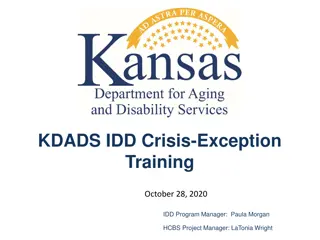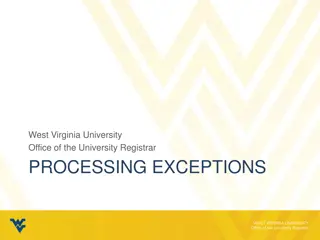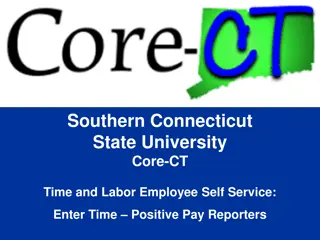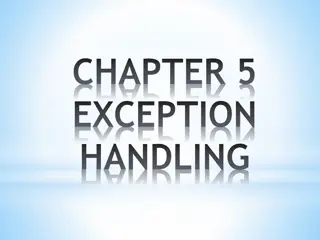Understanding Exception Handling in C#
Exceptions in programming are runtime errors that can disrupt program execution if not handled properly. In C#, exceptions are represented by objects of the System.Exception class or its subclasses. Exception handling involves using keywords like try, catch, throw, and finally to manage errors and ensure program continuity. This tutorial covers the basics of handling exceptions in C# with examples and explanations of key concepts.
Download Presentation

Please find below an Image/Link to download the presentation.
The content on the website is provided AS IS for your information and personal use only. It may not be sold, licensed, or shared on other websites without obtaining consent from the author. Download presentation by click this link. If you encounter any issues during the download, it is possible that the publisher has removed the file from their server.
E N D
Presentation Transcript
Exception Handling LECTURE #12
Exceptions Exceptions are run-time errors that can stop the program execution unless they are handled properly. Exceptions are generated when certain conditions occur in your program, such as dividing by zero, trying to open a file that was erased, incorrect casting, or running out of memory. you deal with the exception by using the appropriate handler in order to prevent the program from stopping. The handler is a block of code that catches the exception and tries to continue the program execution. If the appropriate handler is not available in your code, the default handler is used and the program is terminated.
Exceptions In C#, an exception is an object of the class System.Exception or one of its subclasses, which represents an error that occurred during the program execution. Exceptions provide a way to transfer control from one part of a program to another. C# exception handling keywords: try, catch, throw and finally. is built upon four
Exceptions Handling exceptions requires using a special construct that uses one of the following statements: othrow: To throw or rethrow an exception. otry-catch: To catch and handle the exception otry-catch-finally: To catch and handle the exception and clean up resources
Throwing an exception The throw statement takes the following form: throw [expression]; where: Expression is the exception object. Some of the exceptions that can be thrown by an application are: o InvalidCastException o OverFlowException o ArgumentNullException o ArithmeticException o DivideByZeroException
namespace ExceptionHandling_1 { class Program { static void Main(string[] args) { string str; str = "SSUET"; Console.WriteLine(str); str = null; if (str == null) { throw new ArgumentNullException(); } // The following line will not be executed: Console.Write("myString is null."); } } }
namespace ConsoleApplication4 { class Program { static void Main(string[] args) { int a, b; Console.WriteLine("Enter first number"); a = Convert.ToInt32(Console.ReadLine()); Console.WriteLine("Enter second number"); b = Convert.ToInt32(Console.ReadLine()); if (b == 0) { throw new DivideByZeroException(); } else Console.WriteLine("Answer is:"+a / b); Console.Read(); } } }
Catching an Exception You can catch exceptions by using the try-catch statement, which contains two blocks. The first is the try block, inside which the suspicious code is inserted. It takes the form: try {// The code to be tried. } catch [(declaration)] { // The handler code. } where: declaration is the exception object declaration and is optional.
Catching an Exception The two blocks are used together to build one statement. If you attempt to use the try block alone, you will get the compilation error: error CS1524: Expected catch or finally.
Catching an Exception It is also possible to use more than one catch block. In this case, the try-catch statement takes the form: try { // block of code to monitor for errors } catch (ExcepType1 exOb) { // handler for ExcepType1 } catch (ExcepType2 exOb) { // handler for ExcepType2 }
Exception Class and Properties The Exception class has several properties that make understanding an exception easier. These properties include: The StackTrace property. This property contains a stack trace that can be used to determine where an error occurred. The stack trace includes the source file name and program line number if debugging information is available. The Message property. This property provides details about the cause of an exception TargetSite obtains an object that specifies the method that generated the exception.
namespace ExceptionHandling_2 { class Program { public void Method1(string str) { if (str == null) throw new ArgumentNullException(); } static void Main(string[] args) { Program p1 = new Program(); try { string str = null; p1.Method1(str); } catch (Exception e) { Console.WriteLine("Exception is caught message is {0}",e.Message); } Console.WriteLine("Now program Continues"); Console.ReadLine(); } } }
namespace ExceptionHandling_2 { class Program { public void Method1(string str) { if (str == null) throw new ArgumentNullException(); } static void Main(string[] args) { Program p1 = new Program(); try { string str = null; p1.Method1(str); } catch (Exception e) { Console.WriteLine("Exception stacktrace{0}",e.StackTrace); } Console.WriteLine("Now program Continues"); Console.ReadLine(); } } }
Catching an Exception Using the Exception class as a parameter in a catch block is equivalent to not using a parameter at all. That means: catch (Exception) {} is equivalent to: catch {} You can use a parameter, such as Exception e, if you would like to display the exception text that is associated with the object e.
Organizing the Handlers When you use more than one catch block, it is important to catch the most specific exceptions before the least specific ones. If, for example, the mostspecific exception is ArithmeticException, this exception should be thefirst one to catch. Then you organize the rest of the handlers in order, ending with the most general exception.
Organizing the Handlers catch (ArithmeticException e) // first handler { //... } ... ... catch (Exception e) // last handler { // ... }
Organizing the Handlers Although the sequence of the exception handlers is totally up to your judgment, you cannot have the general handler before the specific ones. If you do that, you get the following compiler error: error CS0160: A previous catch clause already catches all exceptions error CS0160: A previous catch clause already catches all exceptions of this or of a super type (' of this or of a super type ('System.Exception System.Exception'). ').
namespace ExceptionHandling_2 { class Program { static void Main(string[] args) { int x, y; x = 6; y = 0; try { Console.WriteLine("Division is :{0}", x / y); } catch (DivideByZeroException d) { Console.WriteLine("Exception caught {0}", d); } catch (Exception e) { Console.WriteLine("Exception caught {0}", e); } Console.ReadLine(); } } }
namespace ConsoleApplication4 { class Program { static void Main(string[] args) { // Here, numer is longer than denom. int[] numer = { 4, 8, 16, 32, 64, 128, 256, 512 }; int[] denom = { 2, 0, 4, 4, 0, 8 }; for (int i = 0; i < numer.Length; i++) { try { Console.WriteLine(numer[i] + " / " + denom[i] + " is " + numer[i] / denom[i]); } catch (DivideByZeroException) { Console.WriteLine("Can't divide by Zero!"); } catch (IndexOutOfRangeException) { Console.WriteLine("No matching element found."); } } Console.Read(); } } }
The try-catch-finally Statement The try-catch-finally statement takes the form: try {//try-block} catch {//catch-block} finally {//finally-block}
The try-catch-finally Statement where: try-block contains the suspicious code to be tried. catch-block contains the exception handler. finally-block contains the cleanup statements to be executed regardless of the exception.
class UseFinally { public static void GenException(int what) { int t; int[] nums = new int[2]; Console.WriteLine("Receiving " + what); try { switch(what) { case 0: t = 10 / what; // generate div-by-zero error break; case 1: nums[4] = 4; // generate array index error break; case 2: return; // return from try block } }
catch (DivideByZeroException) { catch (IndexOutOfRangeException) { Console.WriteLine("No matching element found.");} finally { Console.WriteLine("Leaving try."); } class program { static void Main(string[] args) { for (int i = 0; i < 3; i++) { UseFinally.GenException(i); Console.WriteLine(); } Console.Read(); } } } Console.WriteLine("Can't divide by Zero!"); }
User-defined Exceptions You can create an exception of your own by declaring it as a class derived from the ApplicationException class. The benefit to the programmer is the ability to add to the handlers whatever text is needed to explain in detail the error that took place.
User-defined Exceptions You can inherit the ApplicationException as shown in this example: class MyCustomException: ApplicationException A constructor with a string parameter is used to send it as a message to the inherited class: MyCustomException(string message): base(message) { } The string parameter contains the message you would like to display when the exception is thrown























